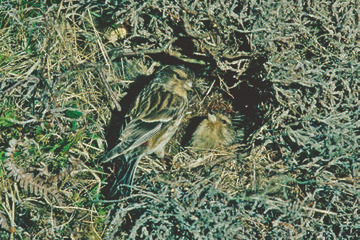
Twite © Peter Smith
There were no records of Twite during the breeding season in this survey, but they bred during our First Atlas, in two different habitats at the lowest and highest points of the county. In 1978-84, Twites were recorded in 13 tetrads, 1 with confirmed breeding, 3 probable and 9 possible. Most of the birds were in the moorland of the eastern hills. Records from this area continued to be submitted to the annual bird reports, with the largest count in 1989 with evidence of ‘a possible ten pairs on the Cheshire side of the eastern hills’. After that year, however, only sporadic breeding season records were received, with none from 1991 to 1993, odd records in 1994 and 1995, none in 1996, and one singing bird in 1997. Following two years of absence in 1998 and 1999, it was thought that a pair at Shining Tor on 13 July 2000 ‘may have bred locally’. If they did, they were the last known breeders in the county.
Twite also used to nest alongside the estuaries. In the mid-1970s there were confirmed breeding records at New Ferry and possible breeding at Frodsham, but there has been no summer record from the Mersey for thirty years. On the Dee saltmarsh, a nest was found in 1967, then a pair seen feeding small young in 1979, the origin of the confirmed breeding record during our First Atlas. An adult was seen there on 22 June 1980, but there has been no subsequent record.
As a Red-listed species of conservation concern, the Twite’s ecology has come in for detailed study in recent years. The breeding season lasts from early May to late July, allowing up to three broods in favourable conditions. They breed at quite low densities, from 2 to 14 pairs per tetrad, in open moorland, nesting in tall heather and bracken, but get most of their food from pastures and meadows, possibly as far as 3 km away, flying to and fro on well-defined flight lines when feeding young. As with other cardueline finches, they eat small seeds such as dandelion and sorrel, storing food in their crops to be regurgitated for the chicks (Brown & Grice 2005).
Their extinction in Cheshire is just part of a wider population decline. Surveys of the South Pennines Moors SPA, including the Cheshire moors, showed an 84% drop between 1990 and 2004-05 in the breeding population of Twites (Eaton et al 2007). The reasons for their demise are not well established, however. Overgrazing by sheep and bracken removal have reduced the area of suitable nesting habitat, and their food supply has greatly diminished as many pastures are overstocked or cut early for silage, so flowers rarely set seed. Even roadside verges, potentially a rich source of seeds, are often cut in the name of ‘tidiness’ (Brown & Grice 2005). Even without these symptoms of modern countryside management, Twites are northern breeding birds of cool, wet places and climate change will make English moorlands even less hospitable for them: they are likely to be lost from England later this century (Huntley et al 2007).
Sponsored by Richard Gabb

